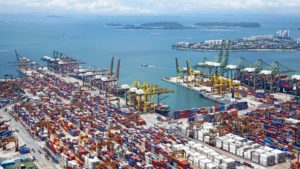How do you navigate your supply chain journey now while planning for tomorrow? Two leading thought leaders from Kinaxis debated that very topic at the recent Big Ideas in Supply Chain webinar in October
John Sicard has had the opportunity to talk with a great many supply chain leaders over the course of the past 18 months and in doing so he has witnessed a new, unifying narrative forming. “What got us through the past 30 years may not survive the next three,” believes the President & CEO of supply chain planning specialist Kinaxis.
“Many boards are asking their CEOs, ‘What are we going to do the next time we experience this level of volatility and disruption?’” Of course, that’s a complicated question with myriad of potential responses. What’s clear – and Sicard confirmed this in his opening presentation at the recent Kinaxis ‘Big Ideas in Supply Chain’ virtual conference – current techniques for governing supply chains are “failing the resiliency test”.

Kinaxis delivers supply chain agility and resiliency to supply chains around the world by combining human intelligence with AI and concurrent planning to help companies plan for any future, monitor risks and opportunities, and respond at the pace of change. Its industry-proven applications and extensible, cloud-based ‘RapidResponse’ platform empowers planners, business leaders and IT professionals to know sooner, act faster and remove waste.
Service to humanity
“When friends or family ask me what Kinaxis does, I often say we’re helping to save the planet – or we’re helping humanity to thrive,” Sicard reports. “I say that because supply chain as a discipline is in service to humanity – it always has been, and it always will be. And supply chains can only function by consuming the Earth’s natural resources. So, our mission is to help companies plan better, live better and ultimately change the world, and we are contributing to that with our invention of a new planning technique.”
Kinaxis recently released what it describes as fastest implementation methodology for an end-to-end supply chain transformation, one that introduces breakthrough performance in a matter of weeks, something that most companies are demanding these days.
“Even in the past 20 years alone, we are no strangers to disruption – strikes, weather events, pandemics, geopolitical unrest,” adds Sicard’s Kinaxis colleague, Anne Robinson, Chief Strategy Officer.
It feels as if the supply chain disruptions are just starting to hit their peak – perhaps this is the reason everyone is looking to transform the way they govern their supply chains
Covid-19 has, of course, been wholly different as it has affected “our very way of life” – every person, business and geography – in “profound ways”. But, Robinson feels, it is likely that the medical side of Covid-19 will likely end much sooner than the supply chain side effects it has created. “It feels as if the supply chain disruptions are just starting to hit their peak – perhaps this is the reason everyone is looking to transform the way they govern their supply chains all over the world.”
Sicard goes on to explain that a generational shift is underway and there are many “trailblazing” companies “cutting a path for others to follow” – the breed of companies you expect to see adorning the Gartner innovation leagues. “What they have in common is they know they needed to rethink and even rebuild the foundation on which supply chain planning is built. They have altered the basic technique to drive agility, and agility is the muscle that brings resilience,” continues Sicard. “If it’s the techniques that have shown to be failing rather than the technologies that support those flawed techniques, technologies don’t really matter,” he notes.

Sicard illustrates the point with a typical supply chain process map – in his own words, a “messy, complicated and chaotic” supply chain that may have been best practice 30 years ago, when the pace of business was considerably slower than it is today. But in the 2020s, this is no longer fit for purpose. “It may well have been when the common belief was that, if only you optimised each link in the supply chain, you optimise the entire supply chain. Today, we know better. Maintaining this siloed and lethargic approach, this flawed technique to governing supply chain has resulted in the erosion of trust and confidence between functions. It’s resulted in lethargic course correction when things don’t go as planned. It’s resulted in the inability to understand the end-to-end implications of unexpected events, whether large or small. It’s resulted in the prolific use of Excel as the informal glue to keep all the pieces loosely connected. This approach is simply not sustainable – it will not survive.”
Leveraging concurrent planning has shown positive results across the end-to-end supply chain. In addition to increased value throughout the traditional supply chain metrics – productivity, costs, etc – our customers have reported greater agility and responsiveness to disruptions
Concurrent planning
Maybe it took a global pandemic to drive the adoption to something significantly better. The trailblazers, Sicard observes, have moved away from this cascaded, siloed planning technique to one that is significantly more immersive, inclusive and most importantly one that is concurrent from the financial aspirations that stem from standard operating procedures and integrated business planning through to distribution and delivery, unifying everything and everyone.
“Leveraging concurrent planning has shown positive results across the end-to-end supply chain,” Robinson explains. “In addition to increased value throughout the traditional supply chain metrics – productivity, costs, etc – our customers have reported greater agility and responsiveness to disruptions. This has been paramount over the past 18 months. Many boards are speaking about supply chain and in particular resilience as part of the supply chain. But we need to remember resilience is not a competence, it’s an outcome. The competence is agility. The power of concurrent planning is agility; you’re codifying agility and absorbing uncertainty. This allows you to meet or exceed your customer promises while simultaneously driving out cost.”

But, Robinson adds, cost isn’t the only consideration. Supply chains, by definition, are consumers of the Earth’s natural resources, from raw materials through to finished product. Any improvements in efficiency and execution of the supply chain are ultimately better for the planet. “I believe that sustainability will become one of the most important topics for supply chain practitioners over the coming months,” Robinson insists.
“Many companies are explicitly tying their supply chain practice to the ‘E’ in ESG,” she continues. “Regulators, customers, investors and employees are expecting an increased focus on sustainability. Enabling your sustainability roadmap is more than altruistic – it can have a positive impact on the bottom and top line. However, the challenge is making it real – translating those corporate commitments into operational actions.”
Arguably, the prerequisite to everything is transparency and alignment, according to Sicard. “These are vital to achieving ‘hyper agility’,” he says. “And I use the term transparency on purpose: too many people confuse the terms of visibility and transparency. These are not equivalent; they’re not interchangeable. Visibility is important and interesting. Transparency is what I call vital and valuable.”
You really need this transparency to remove the latency. There’s always going to be something that happens and it can be big or small, but really understanding the implications when there’s an unexpected event, that’s the key to agility
“We want to go from admiring the problem to really understanding the context of the problem,” Robinson offers. “You really need this transparency to remove the latency. There’s always going to be something that happens and it can be big or small, but really understanding the implications when there’s an unexpected event, that’s the key to agility.”
“The future will be to democratise planning,” believes Sicard. “Anyone must be able to simulate any decision, anytime, and from anywhere. And maybe the most important thing is to understand
the end-to-end implications of that decision, from top to bottom.”
“We want to make sure that, in the future, the obvious transactions are hands-free, we want to automate the obvious, so that humans can really rise to the moment when something unexpected arise or requires judgement calls that can’t be entrusted to machines and algorithms,” Robinson states. “I am a believer in the power of predictive and prescriptive analytics for decision-making, but algorithms ultimately lack conscience, collaboration and context. And that’s where we really see humans shine.”
Ultimately, Sicard concludes, we have to recognise that every supply chain has a lot more in common than otherwise. “You don’t need to reinvent this wheel,” he maintains. “Start with best practices, and use rapid sprints to hit value milestones. Don’t let anyone convince you that you’re so unique and special that only a bespoke and custom solution is the path to progress. In fact, I think it’s proven to be the obvious path to obsolescence.
To find out more about Kinaxis supply chain planning software, please email media@kinaxis.com or or log on to the website at www.kinaxis.com/en







